Duoprism
| Set of uniform p-q duoprisms | |
| Type | Prismatic uniform 4-polytopes |
| Schläfli symbol | {p}×{q} |
| Coxeter-Dynkin diagram | |
| Cells | p q-gonal prisms, q p-gonal prisms |
| Faces | pq squares, p q-gons, q p-gons |
| Edges | 2pq |
| Vertices | pq |
| Vertex figure |  disphenoid |
| Symmetry | [p,2,q], order 4pq |
| Dual | p-q duopyramid |
| Properties | convex, vertex-uniform |
| Set of uniform p-p duoprisms | |
| Type | Prismatic uniform 4-polytope |
| Schläfli symbol | {p}×{p} |
| Coxeter-Dynkin diagram | |
| Cells | 2p p-gonal prisms |
| Faces | p2 squares, 2p p-gons |
| Edges | 2p2 |
| Vertices | p2 |
| Symmetry | p,2,p = [2p,2+,2p], order 8p2 |
| Dual | p-p duopyramid |
| Properties | convex, vertex-uniform, Facet-transitive |

In geometry of 4 dimensions or higher, a duoprism is a polytope resulting from the Cartesian product of two polytopes, each of two dimensions or higher. The Cartesian product of an n-polytope and an m-polytope is an (n+m)-polytope, where n and m are 2 (polygon) or higher.
The lowest-dimensional duoprisms exist in 4-dimensional space as 4-polytopes being the Cartesian product of two polygons in 2-dimensional Euclidean space. More precisely, it is the set of points:
where P1 and P2 are the sets of the points contained in the respective polygons. Such a duoprism is convex if both bases are convex, and is bounded by prismatic cells.
Nomenclature
Four-dimensional duoprisms are considered to be prismatic 4-polytopes. A duoprism constructed from two regular polygons of the same edge length is a uniform duoprism.
A duoprism made of n-polygons and m-polygons is named by prefixing 'duoprism' with the names of the base polygons, for example: a triangular-pentagonal duoprism is the Cartesian product of a triangle and a pentagon.
An alternative, more concise way of specifying a particular duoprism is by prefixing with numbers denoting the base polygons, for example: 3,5-duoprism for the triangular-pentagonal duoprism.
Other alternative names:
- q-gonal-p-gonal prism
- q-gonal-p-gonal double prism
- q-gonal-p-gonal hyperprism
The term duoprism is coined by George Olshevsky, shortened from double prism. John Horton Conway proposed a similar name proprism for product prism, a Cartesian product of two or more polytopes of dimension at least two. The duoprisms are proprisms formed from exactly two polytopes.
Example 16-16 duoprism
Schlegel diagram Projection from the center of one 16-gonal prism, and all but one of the opposite 16-gonal prisms are shown. |
net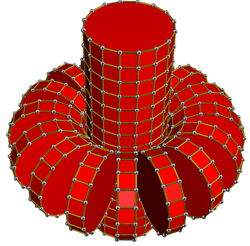 The two sets of 16-gonal prisms are shown. The top and bottom faces of the vertical cylinder are connected when folded together in 4D. |
Geometry of 4-dimensional duoprisms
A 4-dimensional uniform duoprism is created by the product of a regular n-sided polygon and a regular m-sided polygon with the same edge length. It is bounded by n m-gonal prisms and m n-gonal prisms. For example, the Cartesian product of a triangle and a hexagon is a duoprism bounded by 6 triangular prisms and 3 hexagonal prisms.
- When m and n are identical, the resulting duoprism is bounded by 2n identical n-gonal prisms. For example, the Cartesian product of two triangles is a duoprism bounded by 6 triangular prisms.
- When m and n are identically 4, the resulting duoprism is bounded by 8 square prisms (cubes), and is identical to the tesseract.
The m-gonal prisms are attached to each other via their m-gonal faces, and form a closed loop. Similarly, the n-gonal prisms are attached to each other via their n-gonal faces, and form a second loop perpendicular to the first. These two loops are attached to each other via their square faces, and are mutually perpendicular.
As m and n approach infinity, the corresponding duoprisms approach the duocylinder. As such, duoprisms are useful as non-quadric approximations of the duocylinder.
Nets
 3-3 |
 4-4 |
 5-5 |
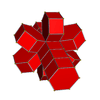 6-6 |
 8-8 |
 10-10 |
 3-4 |
 3-5 |
 3-6 |
 4-5 |
 4-6 |
 3-8 |
Perspective projections
A cell-centered perspective projection makes a duoprism look like a torus, with two sets of orthogonal cells, p-gonal and q-gonal prisms.
 |
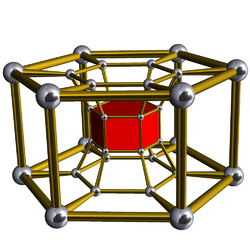 |
| 6-prism | 6-6 duoprism |
|---|---|
| A hexagonal prism, projected into the plane by perspective, centered on a hexagonal face, looks like a double hexagon connected by (distorted) squares. Similarly a 6-6 duoprism projected into 3D approximates a torus, hexagonal both in plan and in section. | |
The p-q duoprisms are identical to the q-p duoprisms, but look different in these projections because they are projected in the center of different cells.
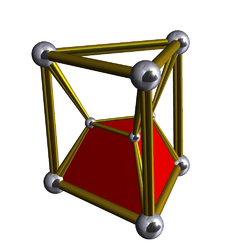 3-3 |
 3-4 |
 3-5 |
 3-6 |
 3-7 |
 3-8 |
 4-3 |
 4-4 |
 4-5 |
 4-6 |
 4-7 |
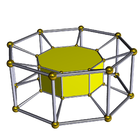 4-8 |
 5-3 |
 5-4 |
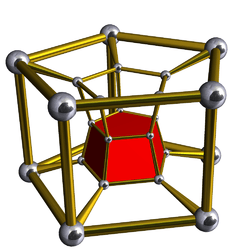 5-5 |
 5-6 |
 5-7 |
 5-8 |
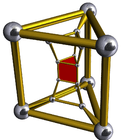 6-3 |
 6-4 |
 6-5 |
 6-6 |
 6-7 |
 6-8 |
 7-3 |
 7-4 |
 7-5 |
 7-6 |
 7-7 |
 7-8 |
 8-3 |
 8-4 |
 8-5 |
 8-6 |
 8-7 |
 8-8 |
Orthogonal projections
Vertex-centered orthogonal projections of p-p duoprisms project into [2n] symmetry for odd degrees, and [n] for even degrees. There are n vertices projected into the center. For 4,4, it represents the A3 Coxeter plane of the tesseract. The 5,5 projection is identical to the 3D rhombic triacontahedron.
| Odd | |||||||
|---|---|---|---|---|---|---|---|
| 3-3 | 5-5 | 7-7 | 9-9 | ||||
 |  |
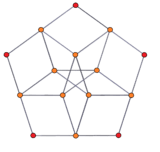 |  |
 |  |
 |  |
| [3] | [6] | [5] | [10] | [7] | [14] | [9] | [18] |
| Even | |||||||
| 4-4 (tesseract) | 6-6 | 8-8 | 10-10 | ||||
 |  |
 |  |
 |  |
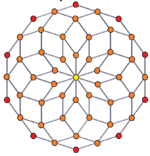 |  |
| [4] | [8] | [6] | [12] | [8] | [16] | [10] | [20] |
Related polytopes

The regular skew polyhedron, {4,4|n}, exists in 4-space as the n2 square faces of a n-n duoprism, using all 2n2 edges and n2 vertices. The 2n n-gonal faces can be seen as removed. (skew polyhedra can be seen in the same way by a n-m duoprism, but these are not regular.)
Duoantiprism
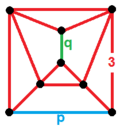
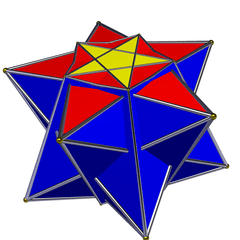
Like the antiprisms as alternated prisms, there is a set of 4-dimensional duoantiprisms: 4-polytopes that can be created by an alternation operation applied to a duoprism. The alternated vertices create nonregular tetrahedral cells, except for the special case, the 4-4 duoprism (tesseract) which creates the uniform (and regular) 16-cell. The 16-cell is the only convex uniform duoantiprism.
The duoprisms ![]()
![]()
![]()
![]()
![]()
![]()
![]() , t0,1,2,3{p,2,q}, can be alternated into
, t0,1,2,3{p,2,q}, can be alternated into ![]()
![]()
![]()
![]()
![]()
![]()
![]() , ht0,1,2,3{p,2,q}, the "duoantiprisms", which cannot be made uniform in general. The only convex uniform solution is the trivial case of p=q=2, which is a lower symmetry construction of the tesseract
, ht0,1,2,3{p,2,q}, the "duoantiprisms", which cannot be made uniform in general. The only convex uniform solution is the trivial case of p=q=2, which is a lower symmetry construction of the tesseract ![]()
![]()
![]()
![]()
![]()
![]()
![]() , t0,1,2,3{2,2,2}, with its alternation as the 16-cell,
, t0,1,2,3{2,2,2}, with its alternation as the 16-cell, ![]()
![]()
![]()
![]()
![]()
![]()
![]() , s{2}s{2}.
, s{2}s{2}.
The only nonconvex uniform solution is p=5, q=5/3, ht0,1,2,3{5,2,5/3}, ![]()
![]()
![]()
![]()
![]()
![]()
![]()
![]()
![]() , constructed from 10 pentagonal antiprisms, 10 pentagrammic crossed-antiprisms, and 50 tetrahedra, known as the great duoantiprism (gudap).[1][2]
, constructed from 10 pentagonal antiprisms, 10 pentagrammic crossed-antiprisms, and 50 tetrahedra, known as the great duoantiprism (gudap).[1][2]
k_22 polytopes
The 3-3 duoprism, -122, is first in a dimensional series of uniform polytopes, expressed by Coxeter as k22 series. The 3-3 duoprism is the vertex figure for the second, the birectified 5-simplex. The fourth figure is a Euclidean honeycomb, 222, and the final is a paracompact hyperbolic honeycomb, 322, with Coxeter group [32,2,3], . Each progressive uniform polytope is constructed from the previous as its vertex figure.
| Space | Finite | Euclidean | Hyperbolic | ||
|---|---|---|---|---|---|
| n | 4 | 5 | 6 | 7 | 8 |
| Coxeter group |
2A2 | A5 | E6 | =E6+ | =E6++ |
| Coxeter diagram |
|||||
| Symmetry | [[3<sup>2,2,-1</sup>]] | [[3<sup>2,2,0</sup>]] | [[3<sup>2,2,1</sup>]] | [[3<sup>2,2,2</sup>]] | [[3<sup>2,2,3</sup>]] |
| Order | 72 | 1440 | 103,680 | ∞ | |
| Graph |  |
 |
 |
∞ | ∞ |
| Name | −122 | 022 | 122 | 222 | 322 |
See also
Notes
- ↑ Jonathan Bowers - Miscellaneous Uniform Polychora 965. Gudap
- ↑ http://www.polychora.com/12GudapsMovie.gif Animation of cross sections
References
- Regular Polytopes, H. S. M. Coxeter, Dover Publications, Inc., 1973, New York, p. 124.
- Coxeter, The Beauty of Geometry: Twelve Essays, Dover Publications, 1999, ISBN 0-486-40919-8 (Chapter 5: Regular Skew Polyhedra in three and four dimensions and their topological analogues)
- Coxeter, H. S. M. Regular Skew Polyhedra in Three and Four Dimensions. Proc. London Math. Soc. 43, 33-62, 1937.
- The Fourth Dimension Simply Explained, Henry P. Manning, Munn & Company, 1910, New York. Available from the University of Virginia library. Also accessible online: The Fourth Dimension Simply Explained—contains a description of duoprisms (double prisms) and duocylinders (double cylinders). Googlebook
- John H. Conway, Heidi Burgiel, Chaim Goodman-Strass, The Symmetries of Things 2008, ISBN 978-1-56881-220-5 (Chapter 26)
- Norman Johnson Uniform Polytopes, Manuscript (1991)
- N.W. Johnson: The Theory of Uniform Polytopes and Honeycombs, Ph.D. Dissertation, University of Toronto, 1966
- Olshevsky, George. "Duoprism". Glossary for Hyperspace. Archived from the original on 4 February 2007.
- Olshevsky, George. "Cartesian product". Glossary for Hyperspace. Archived from the original on 4 February 2007.
- Catalogue of Convex Polychora, section 6, George Olshevsky.